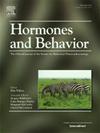Endocrine and behavioral responses to ecological and social challenges in wild Geoffroy's spider monkeys
IF 2.4
3区 医学
Q2 BEHAVIORAL SCIENCES
引用次数: 0
Abstract
To maintain homeostasis during external and internal challenges, vertebrates activate allostatic systems, such as the hypothalamic-pituitary-adrenal (HPA) axis. Additionally, animals can use behavioral responses to address such challenges, which may result in the reduction of allostatic processes. We assessed whether HPA activation is influenced by subgroup formation patterns during ecological and social challenges. We selected Geoffroy's spider monkeys (Ateles geoffroyi) as study subjects, because they are characterized by a high degree of fission-fusion dynamics. We expected spider monkeys to address challenges by being in smaller subgroups when food availability is lower, in larger subgroups when perceived predation risk is higher, and either in larger subgroups or in proximity of more individuals when the likelihood of between-group encounters is higher. For 20 months, we collected behavioral data and fecal samples from 30 wild adult and subadult spider monkeys at the Otoch Ma'ax Yetel Kooh reserve in the Yucatán peninsula, Mexico, and assessed food availability in their home range. In support of our predictions, fecal glucocorticoid metabolite (fGCM) concentrations were negatively associated with food availability, and they were lower when in smaller subgroups than in larger subgroups during low food availability. Fecal GCM concentrations were positively associated with alarm call rates and were lower when in larger subgroups than when in smaller subgroups during high perceived predation risk. We found no evidence for an association between fGCM concentrations and the likelihood of between-group encounters. Overall, subgroup formation patterns interact with HPA activity to successfully address ecological challenges in wild Geoffroy's spider monkeys. Our study highlights the importance of assessing ecological challenges and behavioral responses when interpreting HPA activation in the wild.
野生Geoffroy蜘蛛猴对生态和社会挑战的内分泌和行为反应
为了在外部和内部挑战中保持体内平衡,脊椎动物激活适应系统,如下丘脑-垂体-肾上腺(HPA)轴。此外,动物可以使用行为反应来应对这些挑战,这可能导致适应过程的减少。我们评估了在生态和社会挑战中HPA的激活是否受到亚群形成模式的影响。我们选择杰弗里的蜘蛛猴(Ateles geoffroyi)作为研究对象,因为它们具有高度的裂变融合动力学特征。我们期望蜘蛛猴在食物供应不足时,能在较小的亚群中应对挑战;当感知到被捕食的风险较高时,能在较大的亚群中应对挑战;当群体间相遇的可能性较高时,能在较大的亚群中应对挑战;在20个月的时间里,我们在墨西哥Yucatán半岛的Otoch Ma'ax Yetel Kooh保护区收集了30只野生成年和亚成年蜘蛛猴的行为数据和粪便样本,并评估了它们家乡范围内的食物供应情况。为了支持我们的预测,粪便糖皮质激素代谢物(fGCM)浓度与食物可得性呈负相关,在食物可得性低的情况下,较小亚组的粪便糖皮质激素代谢物浓度低于较大亚组。粪便GCM浓度与报警率呈正相关,并且在高感知捕食风险时,较大亚组中的浓度低于较小亚组中的浓度。我们没有发现fGCM浓度与组间接触可能性之间存在关联的证据。总的来说,亚群形成模式与HPA活动相互作用,成功地解决了野生Geoffroy蜘蛛猴的生态挑战。我们的研究强调了在解释野生HPA激活时评估生态挑战和行为反应的重要性。
本文章由计算机程序翻译,如有差异,请以英文原文为准。
求助全文
约1分钟内获得全文
求助全文
来源期刊

Hormones and Behavior
医学-行为科学
CiteScore
6.70
自引率
8.60%
发文量
139
审稿时长
91 days
期刊介绍:
Hormones and Behavior publishes original research articles, reviews and special issues concerning hormone-brain-behavior relationships, broadly defined. The journal''s scope ranges from laboratory and field studies concerning neuroendocrine as well as endocrine mechanisms controlling the development or adult expression of behavior to studies concerning the environmental control and evolutionary significance of hormone-behavior relationships. The journal welcomes studies conducted on species ranging from invertebrates to mammals, including humans.
 求助内容:
求助内容: 应助结果提醒方式:
应助结果提醒方式:


